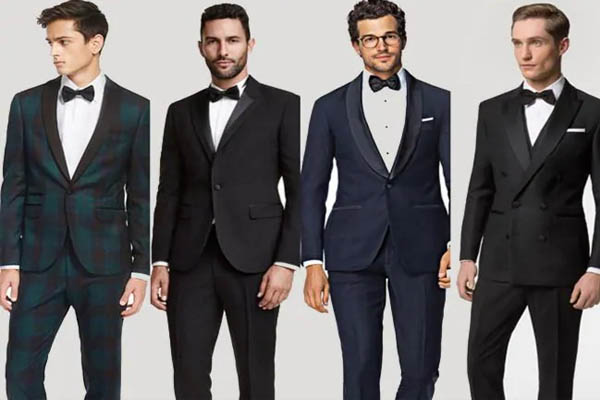A suit often reflects a man’s style and elegance. Every man must have at least one suit that is both sophisticated and fit him perfectly. One of the most noteworthy features of what makes a suit look good on a man is the construction and appearance of the suit jacket.
Buying a suit jacket is a tricky problem for most men. What to look for in a men’s suit jacket is the most suitable question here.A great suit makes a man appear trimmer, taller and stronger.
Difference between Single-breasted & Double-Breasted Suit Jackets
A single-breasted jacket consists of two halves that button together at the front. The style looks classic and is widely used. Generally, a single breast jacket includes one to four buttons. It looks best with notch lapel.
A double-breasted jacket is used as a more formal look than a single-breasted jacket. There are usually four to eight buttons on the front with six as a standard. A peak lapel is a defining feature of double-breasted jacket. The jacket takes extra fabric to fold over from left to right.
There are three main types of suit lapels: notched, peaked and shawl. Each of these lapels come in different widths, ranging from super slim, around 2.25 inches, to super-wide, around 5 inches. A normal lapel will be between 3 and 3.5 inches.
Notch lapel:
A “notch” is a V-shaped indentation, and this style lapel is called “notched” because you can see a sideways “V” shape (like “>” and “<“) where the lapel meets the jacket collar. The notched lapel is by far the most common lapel found on suits. This lapel is traditional and classic.
Peak Lapel:
a peaked lapel comes to a “peak” at the lapel edge, where it points upwards. This lapel is all business, all the time. There’s nothing casual about it.
Shawl Lapel:
This lapel has no notch nor peak. It’s all lapel with a rounded edge.there’s really no hard-and-fast rule in terms of width on this one.\
Sack Silhouette Suit:
“The sack” actually comes from the French “sacque”, which is a particular construction technique for coats and jackets. The jacket, in fact, is made out of only two straight fabric panels. A technique that would be perfect for large scale production of clothes.
The jacket also comes with almost no padding and a straight silhouette. It is usually single-breasted, with two or three buttons. The canvas features no darts, which – in case you’re not familiar – are folds in the canvas layer that give it a more voluminous look.
Structured Silhouette Suit:
Influenced by the military uniform – this is the most formal silhouette for a suit jacket. The shoulders are padded and the waist is trim giving the wearer an almost hourglass appearance.
Fitted Silhouette Suit:
This silhouette suits men who are in shape. It presents a tailored fit. With minimal padding, the posture is enhanced by the use of high armholes.
Suit Jacket Pocket Types:
A standard feature of a suit jacket is a pocket on the left side of the chest. This is called the jacket breast pocket. You’ll notice in some of my videos – my suit jacket has a pocket on the right. Any guesses why? The flaps on the pockets should be consistent with the size of the lapels – neither too large nor too small.
The jetted pocket is more dressy, which explains why it is traditionally found on the tuxedo.
The flap pocket will add a touch of thickness on the hip, while the slit pocket gives a slimmer look.
Angled pockets are sportier and should always have a flap.
A ticket pocket was originally used to hold train tickets.
A patch pocket is suitable for a sports jackets but not for a formal suit.
Suit Jacket Vents:
Suit jackets may or may not have a vent or slit in the lower back portion. The three options for vents in a suit jacket are:
No Vent (ventless) – Preferred by Italians, this style is more fitted. The downside is when you put your hands in your pockets or sit down – the jacket creases and bunches up in the back.
Single Vent – I am not a fan of the single vent suit jacket for men. It exposes their backside when they place their hands in the trouser pockets. The least expensive option – it gives the wearer a boxy appearance.
Double or Two-Sided Vent – Allows for more fluid movement hands. It gives the wearer added shape. The flap comes up when you sit or put your hands in your pockets – preventing the jacket from creasing and keeps the backside covered.
Unlined, Half-lined & Fully-lined Suit Jacket Linings
A natural fiber lining on the inside of a suit jacket is a sign of quality.
Bemberg is a natural form of rayon made from cotton linter. It’s considered the king of linings as it’s durable, relatively inexpensive, breathable, and easy to find. Silk is a luxury fabric and therefore expensive. Although sought after for suits, especially custom, I don’t recommend it is difficult to clean and impossible to fix if torn (you need to replace it). It is breathable though, so an option for hot weather.
Polyester or oil based rayon linings are common in low-cost and mass manufactured jackets – avoid them as they are the least breathable.
The inner jacket lining is usually color-coordinated with the suit fabric. If you decide to go with a contrasting color, it makes the suit more casual (although you can keep it buttoned and no one will know). A lining provides a suit jacket with durability and helps to maintain its line.
An unlined suit jacket is bound to cost more than a suit that is completely lined. Why? Labor and skill – unlined jackets are rare and the artist building the coat will need to ensure his inner stitching is beautiful as the suit jacket’s owner will be able to see it.

